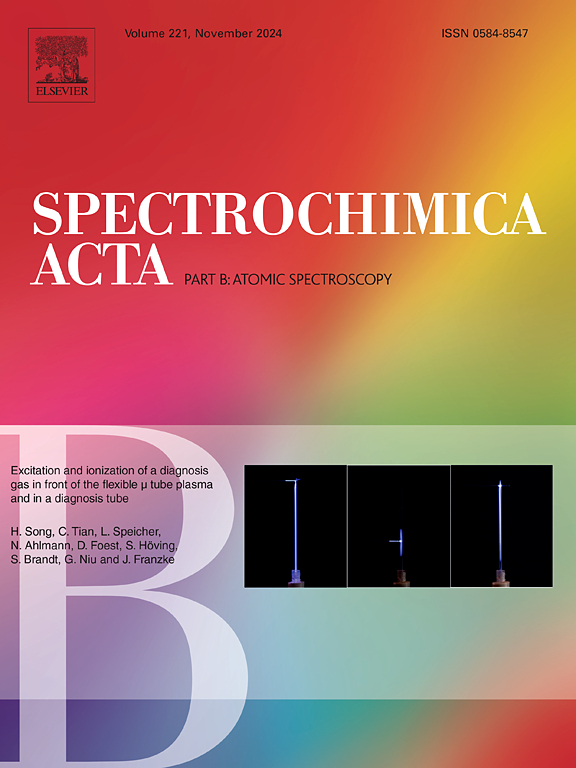Determination of minor and trace elements in human hair - an interlaboratory comparison
IF 3.8
2区 化学
Q1 SPECTROSCOPY
引用次数: 0
Abstract
This article discusses the results of an interlaboratory comparison for the analysis of elemental concentration in human hair samples as an example of a human biological material. The analysis concerned the determination of the content of the following elements: P, S, Cl, K, Ca, Ti, Cr, Mn, Fe, Co, Ni, Cu, Zn, As, Se, Br, Rb, Sr, Mo, Pb and Hg. Six laboratories from five countries (Poland, Germany, Spain, Portugal, and Croatia) participated in the interlaboratory comparison and performed the analyses using the following methods: TXRF (three laboratories), μ-EDXRF (one laboratory), ICP-OES (one laboratory), and ICP-MS (two laboratories). The statistical analysis of the results was performed separately for the TXRF measurements and also including the results obtained using other measurement techniques. The element concentrations obtained by TXRF cover wide range from about 0.2 mg/kg (Mn As Se Rb Sr Pb) to 37,000 mg/kg (S). Additionally, for the TXRF technique, the detection limits (from 0.1 mg/kg to 20–80 mg/kg (the lightest element P)) as well as the intra-day (from 0.2 % to 22 %) and inter-day (from 0.3 % to 19 %) precisions were estimated. For identification and rejection of outliers the Dixon's and the Grubbs' tests were applied. For the remaining results the consensus mean values and standard deviations of element concentrations were calculated. Next, these parameters were used to determine the z-scores for concentration of each element ranging in the interval − 2 ≤ z ≤ 2. In order to compare the dispersion of results, coefficients of variation were determined. It was shown, that the value of variation coefficient depends on the studied element and its concentration in the sample. The obtained results made it possible to estimate the reproducibility of elemental analysis of hair samples performed using various methods in a wide range of atomic numbers and element contents.

人发中微量元素的测定。实验室间比较
本文讨论了作为人类生物材料的一个例子的人发样品中元素浓度分析的实验室间比较的结果。分析涉及以下元素的含量:P、S、Cl、K、Ca、Ti、Cr、Mn、Fe、Co、Ni、Cu、Zn、As、Se、Br、Rb、Sr、Mo、Pb和Hg。来自5个国家(波兰、德国、西班牙、葡萄牙和克罗地亚)的6个实验室参与了实验室间比较,采用TXRF(3个实验室)、μ-EDXRF(1个实验室)、ICP-OES(1个实验室)和ICP-MS(2个实验室)进行了分析。对TXRF测量结果的统计分析是单独进行的,也包括使用其他测量技术获得的结果。TXRF法测得的元素浓度范围从0.2 mg/kg (Mn、As、Se、Rb、Sr、Pb)到37000 mg/kg (S)不等。此外,对TXRF技术的检出限(0.1 mg/kg ~ 20 ~ 80mg /kg(最轻元素P))以及日间(0.2% ~ 22%)和日间(0.3% ~ 19%)精密度进行了估计。为了识别和排除异常值,应用了Dixon和Grubbs检验。对于剩余的结果,计算元素浓度的一致平均值和标准差。接下来,利用这些参数确定各元素浓度在−2≤z≤2区间内的z分数。为了比较结果的离散性,确定了变异系数。结果表明,变异系数的取值取决于所研究的元素及其在样品中的浓度。所获得的结果使得可以估计使用各种方法在广泛的原子序数和元素含量范围内对头发样品进行元素分析的再现性。
本文章由计算机程序翻译,如有差异,请以英文原文为准。
求助全文
约1分钟内获得全文
求助全文
来源期刊
CiteScore
6.10
自引率
12.10%
发文量
173
审稿时长
81 days
期刊介绍:
Spectrochimica Acta Part B: Atomic Spectroscopy, is intended for the rapid publication of both original work and reviews in the following fields:
Atomic Emission (AES), Atomic Absorption (AAS) and Atomic Fluorescence (AFS) spectroscopy;
Mass Spectrometry (MS) for inorganic analysis covering Spark Source (SS-MS), Inductively Coupled Plasma (ICP-MS), Glow Discharge (GD-MS), and Secondary Ion Mass Spectrometry (SIMS).
Laser induced atomic spectroscopy for inorganic analysis, including non-linear optical laser spectroscopy, covering Laser Enhanced Ionization (LEI), Laser Induced Fluorescence (LIF), Resonance Ionization Spectroscopy (RIS) and Resonance Ionization Mass Spectrometry (RIMS); Laser Induced Breakdown Spectroscopy (LIBS); Cavity Ringdown Spectroscopy (CRDS), Laser Ablation Inductively Coupled Plasma Atomic Emission Spectroscopy (LA-ICP-AES) and Laser Ablation Inductively Coupled Plasma Mass Spectrometry (LA-ICP-MS).
X-ray spectrometry, X-ray Optics and Microanalysis, including X-ray fluorescence spectrometry (XRF) and related techniques, in particular Total-reflection X-ray Fluorescence Spectrometry (TXRF), and Synchrotron Radiation-excited Total reflection XRF (SR-TXRF).
Manuscripts dealing with (i) fundamentals, (ii) methodology development, (iii)instrumentation, and (iv) applications, can be submitted for publication.

 求助内容:
求助内容: 应助结果提醒方式:
应助结果提醒方式:


